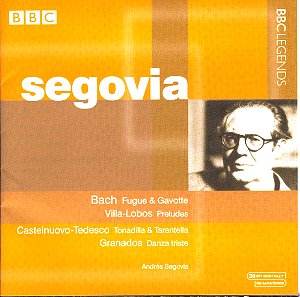It
is a commonplace to describe Andrés Segovia (1893-1987)
as the father of the modern guitar as a concert instrument. The
composer and critic John Duarte expresses it rather well in his
liner note: "Perhaps the most eloquent testimonial to his
work is the observation that without Segovia no-one connected
with the classic guitar would be "sitting" where he
or she is now." This recording of an Edinburgh Festival recital
shows him at the height of his considerable powers.
The
chosen programme illustrates nicely two crucial contributions
which Segovia made to the guitar repertoire of today. The first
part is given over to transcriptions, by Segovia himself, of music,
mainly from the sixteenth and seventeenth centuries which, though
not originally written for the guitar were correctly identified
by him as being eminently suitable for that instrument. The second
part of the programme includes several more modern works inspired
by Segovia’s artistry (and in the case of the pieces by Tansman,
Castelnuovo-Tedesco and Villa-Lobos commissioned by him.)
The
music by Galilei (the father of Galileo Galilei), de Visée
and Bach was all written for the lute but works extremely well
on the modern guitar. The great artist applies delicacy and finesse
to the short pieces by Galilei and though the pieces by de Visée
are also fairly slight he plays them with affection. If you need
an example of what made Segovia a great artist sample the beautiful,
haunting tone which he employs for de Visée’s 'Sarabande'
(track 10). In the Bach pieces the marvellous logic of the German
master’s music is very well served by the clarity of Segovia’s
playing.
Schubert
did not write any significant music for the guitar but, as John
Duarte observes, he did play the instrument and may well have
had it in mind for some of his lieder accompaniments. (Incidentally,
Peter Schreier has made a marvellous recording of Die Schöne
Müllerin, which works really well in this format.) Thus
a transcription of a movement from a piano sonata is not entirely
out of court. In Segovia’s hands the result is wholly convincing.
The way he eases into the trio (track 15, 2’45") and then
plays the trio itself with melting rubato is the work of a master.
Turning
to the more recent pieces. The Tansman is an agreeable little
suite, originally consisting of four movements. The final ‘Danza
pomposa’ was added later to provide a more convincing conclusion;
I can see why. The suite exploits the guitar’s range and Segovia’s
technique very well. Of particular note is the languid ‘Sarabande’
(track 17).
For
the remainder of the programme we are in the Hispanic world. The
two Villa-Lobos preludes complement each other most effectively.
Segovia first plays the haunting, reflective third prelude (track
21) and does it exquisitely. The following first prelude is much
more forthright (could these be called feminine and masculine
compositions?). The pair constitute, for me, the highlight of
the recital. The Castelnuovo-Tedesco ‘Tarantella’ is infectious
with a delightfully puckish pay-off. Listeners should be warned
that on my copy at least there was some surface swishing at the
start of this item (track 24). I wonder if the Granados piece
was an encore on the night? It makes a delightful envoi though
it doesn’t sound very melancholy in this fluent and engaging performance.
Apart
from the one slight blemish mentioned above the recording wears
its years lightly. The sound of the master’s guitar is well caught.
There is some noise from bronchial members of the audience though
this is not too much of a distraction. More of an irritant, I
fear, is the audience’s tendency to break into applause before
the last note of a particular item has died away. However, this
is a small price to pay for hearing this great artist in sovereign
form.
This
CD will be self-recommending to all aficionados of guitar
music. However, it should be of interest to general collectors
as well. It is a fine addition to the BBC Legends catalogue.
John
Quinn

